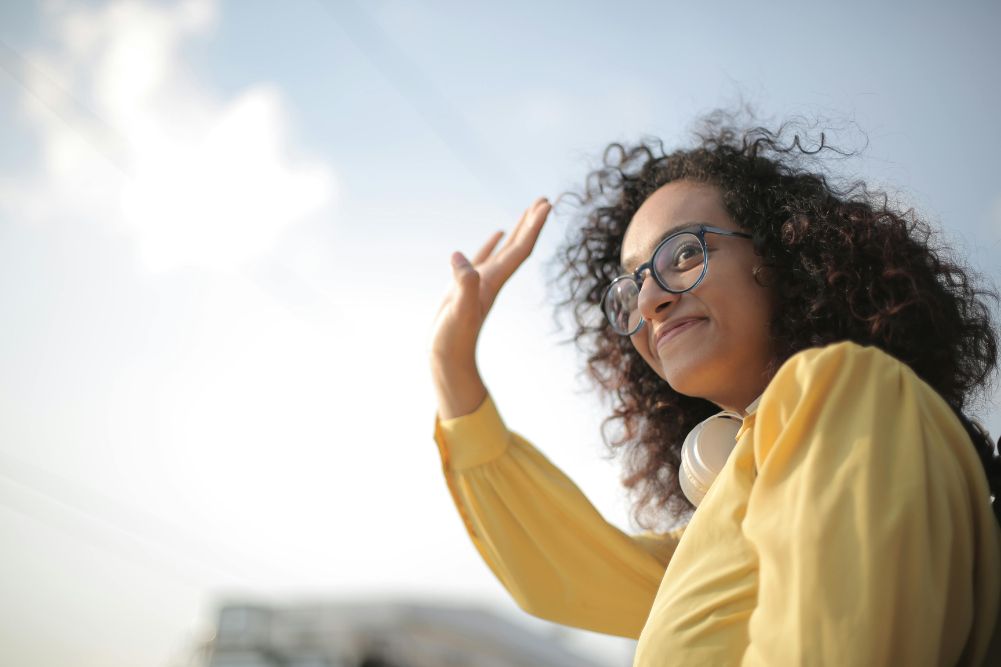Gabrielle Bernstein’s radical, spiritual road
There’s no one quite like Gabrielle Bernstein. Sitting on a white couch in her New York apartment, dressed in designer clothes and crystal jewels blessed by John of God, she speaks of forgiveness while demonstrating a kundalini yoga sequence. It’s yogi meets New York “it” girl: a savvy combination of age-old spirituality with modern-day glamour. And it’s working.
Every generation has its own version of spirituality. In the 1960s it was Eastern philosophy and free love; in the 80s New Age philosophy and self-improvement. And each time, the authenticity of the new “gurus” has been questioned by the old. As the woman The New York Times named a “guru for the next generation”, Bernstein is no different. Not that it bothers her.
With four bestselling books and an appearance on Oprah’s Super Soul Sunday talk show, Bernstein is unapologetic about the way she is bringing spirituality to a new generation. To her tribe of devotees, she’s the real deal.
Growth of a guru
Born in New York, Gabrielle Bernstein was living the dream. After graduating from Syracuse University where she made extra money promoting parties, she started her own business at 21 promoting New York’s best nightclubs — the mecca for her generation. This was at the time when Sex and the City was at its peak, materialism reigned and being seen in a club or wearing the right clothes made you queen.
“Meanwhile, I just felt completely emotionally bankrupt,” she says. “What I was really doing was anaesthetising my deep fears and anxieties — fears that I wasn’t good enough unless I had a romantic partner, fears that I wasn’t good enough unless I got that new client, and fears that I wasn’t good enough if I didn’t have that amount of money.
“I was emotionally and spiritually bankrupt. I spent the first 25 years of my life looking for happiness and self-worth and connectedness in all the wrong places.
“I was looking for this connection in my credentials, and in my relationships, or in a pair of shoes. It was an endless search … terrifyingly difficult and sad.” And that’s what connects with so many people.
Bernstein’s story is familiar. She’s found a way to connect with the generation that was (and still is) addicted to busy-ness, money and appearances. The generation that was told growing up that they could be and do anything they wanted in the world and, by chasing that dream, they would find true happiness.
Well, she got the dream, but the happiness never eventuated. For Bernstein, this resulted in a “very, very bad cocaine addiction” by the age of 25. “I was physically drained, emotionally deteriorating and spiritually dead.”
Like many who have experienced an “awakening”, she knows the exact date of “rock bottom”: the moment when she surrendered to something bigger than herself and asked for help. On October 2, 2005, after a particularly big “party” night, she asked “God, Universe, whoever is out there” for a miracle.
“I woke up that morning and I heard an inner voice,” she told a TEDx event in 2011. “A very authoritative loud inner voice that said to me, ‘Get your life together, girl, and you will live beyond your wildest dreams.’”
Substance addict to “spirit junkie”
And so it began. Over the coming years, she went from cocaine addict to “spirit junkie”, starting with the study of A Course In Miracles.
Probably best known as the work spiritual teacher and author Marianne Williamson refers to throughout her bestselling book A Return To Love, “The Course” — as it is commonly referred to — is a book containing a self-study curriculum about spiritual transformation, comprising three sections: “Text”, “Workbook” and “Manual for Teachers”. It was after Williamson’s appearance and discussion of the book on The Oprah Winfrey Show in 1992 that sales spiked and its popularity grew — something Bernstein herself has also done with a guest spot on Oprah.
“A Course in Miracles came when I was really primed and ready to go deeper into these belief systems and to have a self-taught curriculum. A self-taught curriculum is perfect for me — I don’t want to be told what to do; my mantra is untethered. An untethered force. I want to find my own way.”
This attraction to DIY is something she also believes is so important for her generation — and why her “teachings” work so well. People don’t want to be told what to think like they did with traditional religions; they want to be “guided but still have a sense of freedom”.
“The spiritual practices I have chosen are very loose: they are structured in that they have principles and guidelines, but the rest you can take what you want from them. We are a very wilful generation that doesn’t want to be told what to do, so my message resonates very well.”
It’s also a generation that has faced terrorism in a very new way. Bernstein says she was deeply affected by the terrorist attacks on her home city on September 11, 2001. In her book Spirit Junkie, she talks of the moment of stepping outside of her apartment and into the terror and fear.
“I think that was the moment I realised the world as we know it had changed,” Bernstein tells me. “What I witnessed in my contemporaries was fear — a new type of fear. Not fear like we had before of, ‘Oh, can I get a date?’ but a fear of, ‘Can I walk down the street without fearing terrorism?’ And that is something we all have to deal with every single day. Obviously not as much as in some other countries and cultures, but the truth is it’s a really scary time to be alive.
“And what I believe is that we have to have the tools to combat that fear and we have to have a practice that will keep us in this state of peace and presence and centredness in the midst of the impending problems.”
For Bernstein, that “centredness” comes from daily meditation and prayer, a commitment to the studying and teaching of A Course in Miracles, and kundalini yoga. She is now a trained kundalini teacher and is weaving it all together in books, a hugely successful YouTube channel, social media accounts and international workshops.
“In my practice, there’s no significance of one [teaching] over the other. Everything has been a part of my spiritual path and has played an important role.
“When we embark on a spiritual path we are guided to what we need to open us up and I believe we’re not given anything a moment too soon. It’s like the saying, the universe won’t give you anything you can’t handle. I believe we’re given the resources and teachings that we most need at exactly the right time. Maybe those seeds of teachings are given to us when we’re not really ready for them, but they are planted for us to come back to later when we are ready. So when we need them, we know where to go.
“People always say to me that my book turned up at the perfect time for them — and they think it’s a coincidence. But it’s not. It’s like you send out a universal media alert saying, ‘Hey, I need help!’, and the spiritual boomerang will send you the book you need or the mentor you need. The help you receive will come in the perfect form that will resonate with you. You raise your consciousness to start seeing things differently, so you start to pay attention to more things and the perfect tools begin to appear.
“Our brains have all these different filters, so when we raise our consciousness, it’s like unlocking all these different doors. When we unlock our spiritual path, we unlock a door and allow whatever we need to come through that door.”
The business of connection
For the millions of men and women disheartened by their current goals and careers, and longing to be more connected to something, Bernstein is a refreshing teacher. The language she uses speaks to them, and the way she does it is easily accessible. It also helps that she is a whiz when it comes to self-promotion.
As a marketing and PR force, she certainly knows how to sell her message and connect with her fans. She’s turned her struggle and awakening into a very successful career: on top of her bestselling books, her Hay House radio show reaches tens of thousands each week, her social media followers number in the tens of thousands and she’s about to tour Australia in January 2015.
Says Bernstein, “My work has resonated with a new generation because it has been written in a relevant language.”
Her message is far from new. She herself admits, “The teachings have always been the same as what I am teaching. It’s just that I’m choosing to present it in a different way.” A very successful way.
Does the fact that she is very marketing-savvy make her less of the real deal? Not according to some seriously high-profile supporters, such as Oprah, Marianne Williamson, Deepak Chopra and Wayne Dyer. Or Bernstein herself.
“I think if you do good work in this world you should be paid for it. The most important thing is your higher purpose — the reason you are doing it. Put good work out into the world and you can then be unapologetic about how you live.”
“There’s a belief at the moment that you have to be a certain way to be spiritual — and I think that’s a bunch of bullshit. I believe that being spiritual is being real and acting in ways that are truthful to you, and being connected and aligned with what is real for you. That is spirituality.”
Miracles & messengers
So what is it, exactly, that Bernstein teaches?
Forgive, meditate and expect miracles in your life. As she explains in her third book, May Cause Miracles: “Today I live a miraculous life and am on a mission to help everyone do the same. My dedication to miracles got me to this groovy state. But I’ll be straight up with you: choosing loving thoughts over fearful delusions was a tough transition at first. It seems easy — who doesn’t want to trade in fear for love? But giving up fear is like giving up sugar: they’re both sneaky ingredients that hide out in almost everything. And just when you think you’ve got that craving under control, suddenly it rears its not-so-pretty head again. Therefore, releasing fearful patterns isn’t for dabblers. It requires diligence and commitment. It requires you to become a full-on miracle worker.”
Which is where her work is now taking her. Over the years, Bernstein has shifted her focus from connecting with her “students” one-on-one towards guiding them to become teachers themselves. Her message fluctuates between meditations to release body image issues and how to market yourself and your message in a spiritual and authentic way.
“My goal is to come in, crack them open, wake them up and then send them out as messengers. To take their own version of their spiritual path and spread that to others.
“I see myself and all my students — or my audience — as lightworkers. My hope is that my work will spark the light within my audience so they can then go out and spread the light to others. Spread the joy that they’ve ignited in themselves.
“And my greatest hope is that I can start this in Australia and begin a ripple on the other side of the world.”
Amy Taylor-Kabbaz is a writer, speaker and creator of happymama.com.au. She is the author of Happy Mama: A Spiritual Survival Guide and commentator on parenting and wellbeing. You can follow her on Twitter at @amytaylorkabbaz.







